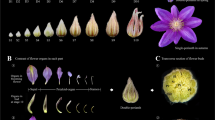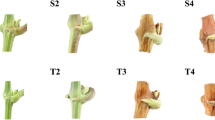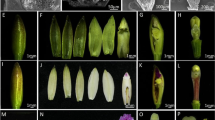Abstract
Daylength is an important environmental cue for synchronizing growth, flowering, and dormancy with seasonality. As many floral development genes are photoperiod regulated, it has been suggested that they could have a regulatory role in bud endodormancy. Therefore, the influence of photoperiod was studied on inflorescence primordia differentiation and floral pathway related gene expression during the development of overwintering buds in Vitis riparia and V. spp. ‘Seyval’. Photoperiod treatments were imposed 35 days after budbreak, and histological and transcriptomic analyses were conducted during the subsequent 42 days of bud development. Long day (LD, 15 h) and short day (SD, 13 h) buds were floral competent by 21 days of photoperiod treatment (56 days after budbreak); however, the floral meristem developed faster in LD than in SD buds. Analysis of 132 floral pathway related genes represented on the Affymetrix Grape Genome array indicated 60 were significantly differentially expressed between photoperiod treatments. Genes predominantly related to floral transition or floral meristem development were identified by their association with distinct grape floral meristem development and an expression pattern in LD consistent with their previously identified roles in flowering literature. Genes with a potential dual role in floral development and dormancy transitioning were identified using photoperiod induced differences in floral development between LD and SD buds and uncharacteristic gene expression trends in relation to floral development. Candidate genes with the potential to play a dual role in SD dormancy induction include circadian rhythm or flowering transition related genes: AP2, BT1, COL-13, EIN3, ELF4, DDTR, GAI and HY5.




Similar content being viewed by others
References
Achard P, Baghour M, Chapple A, Hedden P, Van der Straeten D, Genschik P, Moritz T, Harberd NP (2007) The plant stress hormone ethylene controls floral transition via DELLA dependent regulation of floral meristem-identity genes. PNAS 104:6484–6489
An H, Roussot C, Suárez-López P, Corbesier L, Vincent C, Piñeiro M, Hepworth S, Mouradov A, Justin S, Turnbull C, Coupland G (2004) CONSTANS acts in the phloem to regulate a systemic signal that induces photoperiodic flowering of Arabidopsis. Development 131:3615–3626
Andersen SU, Algreen-Petersen RG, Hoedl M, Jurkiewicz A, Cvitanich C, Braunschweig U, Schauser L, Oh SA, Twell D, Jensen EØ (2007) The conserved cysteine-rich domain of a tesmin/TSO1-like protein binds zinc in vitro and TSO1 is required for both male and female fertility in Arabidopsis thaliana. J Exp Bot 58:3657–3670
Benjamini Y, Hochberg Y (1995) Controlling the false discovery rate: a practical and powerful approach to multiple testing. J R Stat Soc Series B 57:289–300
Ben-Naim O, Eshed R, Parnis A, Teper-Bamnolker P, Shalit A, Coupland G, Samach A, Lifschitz E (2006) The CCAAT binding factor can mediate interactions between CONSTANS-like proteins and DNA. Plant J 46:462–476
Binder BM, Mortimore LA, Stepanova AN, Ecker JR, Bleecker AB (2004) Short-term growth responses to ethylene in Arabidopsis seedlings are EIN3/EIL1 independent. Plant Phys 136:2921–2927
Böhlenius H, Huang T, Charbonnel-Campaa L, Brunner AM, Jansson S, Strauss SH, Nilsson O (2006) CO/FT regulatory module controls timing of flowering and seasonal growth cessation in trees. Science 312:1040–1043
Bond DM, Dennis ES, Pogson BJ, Finnegan EJ (2009) Histone acetylation, VERNALIZATION INSENSITIVE 3, FLOWERING LOCUS C, and the vernalization response. Mol Plant 2:724–737
Boss PK, Thomas MR (2002) Association of dwarfism and floral induction with a grape “green revolution” mutation. Nature 416:847–850
Boss PK, Sreekantan L, Thomas MR (2006) A grapevine TFL1 homologue can delay flowering and alter floral development when overexpressed in heterologous species. Funct Plant Biol 33:31–41
Bowman JL, Smyth DR, Meyerowitz EM (1989) Genes directing flower development in Arabidopsis. Plant Cell 1:37–52
Bowman JL, Smyth DR, Meyerowitz EM (1991) Genetic interactions among floral homeotic genes of Arabidopsis. Development 112:1–20
Butrosse MS (1968) Some effects of light intensity and temperature on dry weight and shoot growth of grapevines. Ann Bot 32:753–765
Butrosse MS (1970) Fruitfulness in grapevines: the response of different cultivars to light, temperature and day length. Vitis 9:21–125
Butrosse MS (1974) Climatic factors and fruitfulness in grapevines. Hortic Abstr 44:319–325
Cai X, Ballif J, Endo S, Davis E, Liang M, Chen D, DeWald D, Kreps J, Zhu T, Wu Y (2007) A putative CCAAT-binding transcription factor is a regulator of flowering timing in Arabidopsis. Plant Physiol 145:98–105
Calonje M, Cubas P, Martinez-Zapater JM, Carmona MJ (2004) Floral meristem identity genes are expressed during tendril development in grapevine. Plant Physiol 135:1491–1501
Carmona MJ, Cubas P, Martinez-Zapater JM (2002) VFL, the grapevine FLORICAULA/LEAFY ortholog, is expressed in meristematic regions independently of their fate. Plant Physiol 130:68–77
Chandler JW, Cole M, Flier A, Werr W (2009) BIM1, a bHLH protein involved in brassinosteroid signaling, controls Arabidopsis embryonic patterning via interaction with DORNRÖSCHEN and DORNRÖSCHEN-LIKE. Plant Mol Biol 69:57–68
Chang S, Puryear J, Cairney J (1993) A simple efficient method for isolating RNA from pine trees. Plant Mol Biol Rep 11:113–116
Chao Q, Rothenberg M, Solano R, Roman G, Terzaghi W, Ecker JR (1997) Activation of the ethylene gas response pathway in Arabidopsis by nuclear protein ETHYLENE-INSENSITIVE3 and related proteins. Cell 89:1133–1144
Chatelet VL, Fernandez L, Sreekantan L, Lacombe T, Martinez-Zapater JM, Thomas MR, Torregrosa L (2007) Characterization of Vitis vinifera L. somatic variants exhibiting abnormal flower development patterns. J Exp Bot 58:4107–4118
Chattopadhyay S, Ang L, Puente P, Deng X, Wei N (1998) Arabidopsis bZIP protein HY5 directly interacts with light-responsive promoters in mediating light control of gene expression. Plant Cell 10:673–683
Cheng Y, Kato N, Wang W, Li J, Chen X (2003) Two RNA binding proteins, HEN4 and HUA1, act in the processing of AGAMOUS Pre-mRNA in Arabidopsis thaliana. Dev Cell 4:53–66
Chouard P (1960) Vernalization and its relations to dormancy. Annu Rev Plant Physiol Plant Mol Biol 11:191–238
Clark SE, Running MP, Meyerowitz EM (1995) CLAVATA3 is a specific regulator of shoot and floral meristem development affecting the same processes as CLAVATA1. Development 121:2057–2067
Colasanti J, Sundaresan V (2000) ‘Florigen’ enters the molecular age: long-distance signals that cause plants to flower. Trends Biochem Sci 25:236–240
Colasanti J, Yuan Z, Sundaresan V (1998) The indeterminate gene encodes a zinc finger protein and regulates a leaf-generated signal required for the transition to flowering in maize. Cell 93:593–603
Corbesier L, Vincent C, Jang S, Fornara F, Fan Q, Searle I, Giakountis A, Farrona F, Gissot L, Turnbull C, Coupland G (2007) FT protein movement contributes to long-distance signaling in floral induction of Arabidopsis. Science 316:1030–1033
Corley SB, Carpenter R, Copsey L, Coen E (2005) Floral asymmetry involves an interplay between TCP and MYB transcription factors in Antirrhinum. PNAS 102:5068–5073
Cramer GR, Ergul A, Grimplet J, Tillett R, Tattersall E, Bohlman M, Vincent D, Sonderegger J, Evans J, Osborne C, Quilici D, Schlauch K, Schooley D, Cushman J (2007) Water and salinity stress in grapevines: early and late changes in transcript and metabolite profiles. Funct Integr Genomics 7:111–134
Dahl M, Meskiene I, Bögre L, Ha DT, Swoboda I, Hubmann R, Hirt H, Heberle-Bors E (1995) The D-type alfalfa cyclin gene cycMs4 complements G1 cyclin-deficient yeast and is induced in the G1 phase of the cell cycle. Plant Cell 7:1847–1857
Dornelas MC, Van Lammeren AA, Kreis M (2000) Arabidopsis thaliana SHAGGY-related protein kinases (AtSK11 and 12) function in perianth and gynoecium development. Plant J 21:419–429
Fennell A, Hoover E (1991) Influence of photoperiod on growth, bud dormancy, and cold acclimation in V. labruscana and V. riparia. J Am Soc Hortic Sci 116:270–273
Fennell A, Sreekantan L, Mathiason K, Grimplet J, Dickerson J, Cramer G, Schlauch K (2009) Transcriptomic profiling and molecular mapping of dormancy induction response in grapevine. Plant & Animal Genomes XVII conference, San Diego CA, January 10–14, p 665
Fernandez L, Torregrosa L, Terrier N, Sreekantan L, Grimplet J, Davies C, Thomas MR, Romieu C, Ageorges A (2007) Identification of genes associated with flesh morphogenesis during grapevine fruit development. Plant Mol Biol 63:307–323
Frugis G, Giannino D, Mele G, Nicolodi C, Chiappetta A, Bitonti MB, Innocenti AM, Dewitte W, Onckelen HV, Mariotti D (2001) Overexpression of KNAT1 in lettuce shifts leaf determinate growth to a shoot-like indeterminate growth associated with an accumulation of isopentenyl-type cytokinins. Plant Physiol 126:1370–1380
Gautier L, Cope L, Bolstad B, Irizarry RA (2004) Affy—analysis of Affymetrix GeneChip data at the probe level. Bioinformatics 20:307–315
Giovannoni J, Yen H, Shelton B, Miller S, Vrebalov J, Kannan P, Tieman D, Hackett R, Grierson D, Klee H (1999) Genetic mapping of ripening and ethylene-related loci in tomato. TAG 98:1005–1013
Grimplet J, Cramer GR, Dickerson JA, Van Hemert J, Mathiason K, Fennell A (2009) VitisNet: Omics integration through grapevine molecular networks. PLoS ONE 4(12):e8365. doi:10.1371/journal.pone.0008365
Hauser BA, He JQ, Park SO, Gasser CS (2000) TSO1 is a novel protein that modulates cytokinesis and cell expansion in Arabidopsis. Development 127:2219–2226
Holefors A, Opseth L, Rosnes AKR, Ripel L, Snipen L, Fossdal CG, Olsen JE (2009) Identification of PaCOL1 and PaCOL2, two CONSTANS-like genes showing decreased transcript levels preceding short day induced growth cessation in Norway spruce. Plant Physiol Biochem 47:105–115
Horvath DP, Anderson JV, Chao WS, Foley ME (2003) Knowing when to grow: signals regulating bud dormancy. Trends Plant Sci 8:534–540
Horvath DP, Chao WS, Suttle JC, Thimmapuram J, Anderson JV (2008) Transcriptome analysis identifies novel responses and potential regulatory genes involved in seasonal dormancy transitions of leafy spurge (Euphorbia esula L.). BMC Genomics 9:536
Irish VF, Sussex IM (1990) Function of the apetala-1 gene during Arabidopsis floral development. Plant Cell 2:741–753
Irizarry RA, Hobbs R, Collin R, Beazer-Barclay YD, Antonellis KJ, Scherf U, Speed TP (2003) Exploration, normalization, and summaries of high density oligonucleotide array probe level data. Biostatistics 4:249–264
Jarillo JA, del Olmo I, Gómez-Zambrano A, Lázaro A, López-González L, Miguel E, Narro-Diego L, Sáez D, Piñeiro M (2008) Review. Photoperiodic control of flowering time. Span J Agric Res 6:221–244
Jofuku KD, den Boer BGW, Van Montagu M, Okamuro JK (1994) Control of Arabidopsis flower and seed development by the homeotic gene APETALA2. Plant Cell 6:1211–1225
Johansen DA (1940) Plant microtechnique. McGraw-Hill, New York
Joly D, Perrin M, Gertz C, Kronenberger J, Demangeat G, Masson E (2004) Expression analysis of flowering genes from seedling-stage to vineyard life of grapevine cv, Riesling. Plant Sci 166:1427–1436
Kagaya Y, Hattori T (2009) Arabidopsis transcription factors, RAV1 and RAV2, are regulated by touch-related stimuli in a dose-dependent and biphasic manner. Genes Genet Syst 84:95–99
Kobayashi A, Yukinaga H, Nii N (1965) Studies on the thermal conditions of grapes. IV. Effect of day and night temperatures on the growth of Delaware. J Jpn Soc Hortic Sci 34:77–84
Kobayashi A, Sugiura A, Watanabe H, Yamamura H (1966) On the effects of day length on the growth and flower bud formation of grapes. Mem Res Inst Food Sci Kyoto Univ 27:15–27
Komaki MK, Okada K, Nishino E, Shimura Y (1988) Isolation and characterization of novel mutants of Arabidopsis thaliana defective in flower development. Development 104:195–203
Kozaki A, Hake S, Colasanti J (2004) The maize ID1 flowering time regulator is a zinc finger protein with novel DNA binding properties. Nucleic Acids Res 32:1710–1720
Kunst L, Klenz JE, Martinez-Zapater J, Haughn GW (1989) AP2 gene determines the identity of perianth organs in flowers of Arabidopsis thaliana. Plant Cell 1:1195–1208
Lagercrantz U (2009) At the end of the day: a common molecular mechanism for photoperiod responses in plants? J Exp Bot 60:2501–2515
Li J, Jia D, Chen X (2001) HUA1, a regulator of stamen and carpel identities in Arabidopsis, codes for a nuclear RNA binding protein. Plant Cell 13:2269–2281
Mathiason K, He D, Grimplet J, Venkateswari J, Galbraith DW, Or E, Fennell A (2009) Transcript profiling in Vitis riparia during chilling requirement fulfillment reveals coordination of gene expression patterns with optimized bud break. Functl Integr Genomics 9:81–96
Menges M, Samland AK, Planchais S, Murray JA (2006) The D-type cyclin CYCD3:1 is limiting for the G1-to-S-phase transition in Arabidopsis. Plant Cell 18:893–906
Moon J, Zhao Y, Dai X, Zhang W, Gray WM, Huq E, Estelle M (2007) A new CULLIN 1 mutant has altered responses to hormones and light in Arabidopsis. Plant Physiol 143:684–696
Noh B, Murphy AS, Spalding EP (2001) Multidrug resistance-like genes of Arabidopsis required for auxin transport and auxin-mediated development. Plant Cell 13:2441–2454
Pfaffl MW (2001) A new mathematical model for relative quantification in real-time RT-PCR. Nucleic Acids Res 29:2002–2007
Pfluger J, Zambryski P (2004) The role of SEUSS in auxin response and floral organ patterning. Development 131:4697–4707
Richmond TA, Bleecker AB (1999) A defect in β-oxidation causes abnormal inflorescence development in Arabidopsis. Plant Cell 11:1911–1923
Rohde A, Bhalerao RP (2007) Plant dormancy in the perennial context. Trends Plant Sci 12:217–223
Rolland F, Sheen J (2005) Sugar sensing and signaling networks in plants. Nutrient sensing through the plasma membrane of eukaryotic cells. Biochem Soc Trans 33:269–271
Rosenquist M, Alsterfjord M, Larsson C, Sommarin M (2001) Data mining the Arabidopsis genome reveals fifteen 14-3-3 genes. Expression is demonstrated for two out of five novel genes. Plant Physiol 127:142–149
Ruonala R, Rinne PLH, Kangasjarvi J, Schoot CV (2008) CENL1 expression in the rib meristem affects stem elongation and the transition to dormancy in Populus. Plant Cell 20:59–74
Ruttink T, Arend M, Morreel K, Storme V, Rombauts S, Fromm J, Bhalerao RP, Boerjan W, Rohde A (2007) A molecular timetable for apical bud formation and dormancy induction in poplar. Plant Cell 19:2370–2390
Saniewski M, Kawa-Miszczak L, Wegrzynowicz-Lesiak E (2000) Role of ABA, gibberellins and auxin in dormancy and dormancy release of tulip bulbs. In: Viémont J, Crabbé J (eds) Dormancy in plants: from whole plant behaviour to cellular control. CAB International publishing, New York, pp 227–245
Schmitz RJ, Hong L, Michaels S, Amasino RM (2005) FRIGIDA-ESSENTIAL 1 interacts genetically with FRIGIDA and FRIGIDA-LIKE 1 to promote the winter—annual habit of Arabidopsis thaliana. Development 132:5471–5478
Soderman E, Hjellstrom M and Engstrom P (2000) High level expression of ATHB7 in transgenic Arabidopsis causes a suppression of elongation growth consistent with a role of ATHB7 in the drought stress response. Abstract conference proceedings 11th international conference on Arabidopsis research, 2000 TAIR accession publication: 1546918
Solano R, Stepanova A, Chao Q, Ecker JR (1998) Nuclear events in ethylene signaling: a transcriptional cascade mediated by ETHYLENE-INSENSITIVE3 and ETHYLENE-RESPONSE-FACTOR1. Genes Dev 12:3703–3714
Song JY, Leung T, Ehler LK, Wang C, Liu Z (2000) Regulation of meristem organization and cell division by TSO1, an Arabidopsis gene with cysteine-rich repeats. Development 127:2207–2217
Sreekantan L, Thomas MR (2005) Genes involved in grapevine flowering. Proceedings Australian society of viticulture and oenology conference: transforming flowers to fruit, Mildura, July 4–6
Sreekantan L, Thomas MR (2006) VvFT and VvMADS8, the grapevine homologues of the floral integrators FT and SOC1, have unique expression patterns in grapevine and hasten flowering in Arabidopsis. Funct Plant Biol 33:1129–1139
Sreekantan L, Torregrosa L, Fernandez L, Thomas MR (2006) VvMADS9, a class B MADS-box gene involved in grapevine flowering, shows different expression patterns in mutants with abnormal petal and stamen structures. Funct Plant Biol 33:877–886
Srinivasan C, Mullins MG (1979) Flowering in Vitis: conversion of tendrils in inflorescences and bunches of grapes. Planta 145:187–192
Srinivasan C, Mullins MG (1980) Effects of temperature and growth regulators on formation of anlagen, tendrils and inflorescences in Vitis vinifera L. Ann Bot 45:439–446
Srinivasan C, Mullins MG (1981) Physiology of flowering in grapevines—a review. Am J Enol Vitic 32:47–63
Sugiura A, Utsunomiya N, Kobayashi A (1975) Effects of day-length and temperature on growth and bunch differentiation of grapevines. Jpn J Hortic Sci 43:387–392
Wang Y, Hu Z, Yang Y, Chen X, Chen G (2009) Function annotation of an SBP-box gene in Arabidopsis based on analysis of co-expression networks and promoters. Int J Mol Sci 10:116–132
Waters MT, Moylan EC, Langdale JA (2008) GLK transcription factors regulate chloroplast development in a cell-autonomous manner. Plant J 56:432–444
Wenkel S, Turck F, Singer K, Gissot L, Gourriere JL, Samach A, Coupland G (2006) CONSTANS and the CCAAT box binding complex share a functionally important domain and interact to regulate flowering of Arabidopsis. Plant Cell 18:2971–2984
Xing D, Zhao H, Li QQ (2008) Arabidopsis CLP1-SIMILAR PROTEIN3, an ortholog of human polyadenylation factor CLP1, functions in gametophyte, embryo, and postembryonic development. Plant Physiol 148:2059–2069
Yanagisawa S, Yoo SD, Sheen J (2003) Differential regulation of EIN3 stability by glucose and ethylene signalling in plants. Nature 425:521–525
Yin Y, Vafeados D, Tao Y, Yoshida S, Asami T, Chory J (2005) A new class of transcription factors mediates brassinosteroid-regulated gene expression in Arabidopsis. Cell 120:249–259
Yoo SK, Chung KS, Joonki K, Lee JH, Hong SM, Yoo SJ, Yoo SY, Lee JS, Ahn JH (2005) CONSTANS activates SUPPRESSOR OF OVEREXPRESSION OF CONSTANS 1 through FLOWERING LOCUS T to promote flowering in Arabidopsis. Plant Physiol 139:770–778
Zhang H, Nocker S (2002) The VERNALIZATION INDEPENDENCE 4 gene encodes a novel regulator of FLOWERING LOCUS C. Plant J 31:663–673
Acknowledgments
This work was funded by the National Science Foundation (NSF) Plant Genome Program DBI0604755 and South Dakota State University Agricultural Experiment Station. The South Dakota State University Functional Genomics Core Facility, supported in part by the NSF funding EPSCoR0091948, was used to conduct histological analysis.
Author information
Authors and Affiliations
Corresponding author
Electronic supplementary material
Below is the link to the electronic supplementary material.
11103_2010_9611_MOESM1_ESM.tif
Online Resource 1. Supplemental Figure 1. Validation of microarray expression data by real-time PCR. LD to SD ratios for every timepoint (i.e. day 1 LD/day 1 SD) were calculated for both real-time PCR and microarray expression values and log2 transformed. A linear regression resulted in individual regression coefficients (R) of 0.977, 0.828, 0.947, 0.751, and 0.842 for EARLY LIGHT-INDUCABLE PROTEIN (ELIP1), Histone H3, stress enhanced protein 2 (SEP2), phosphoenolpyruvate carboxykinase (PEPCK), and indoleacetic acid-induced protein 6 (IAA6), respectively. (TIFF 13 kb)
Rights and permissions
About this article
Cite this article
Sreekantan, L., Mathiason, K., Grimplet, J. et al. Differential floral development and gene expression in grapevines during long and short photoperiods suggests a role for floral genes in dormancy transitioning. Plant Mol Biol 73, 191–205 (2010). https://doi.org/10.1007/s11103-010-9611-x
Received:
Accepted:
Published:
Issue Date:
DOI: https://doi.org/10.1007/s11103-010-9611-x




